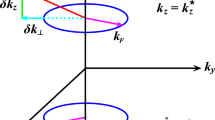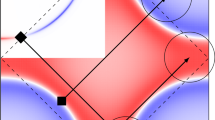Abstract
We generalize the dynamical-mean field theory (DMFT) by including into the DMFT equations dependence on the correlation length of the pseudogap fluctuations via the additional (momentum dependent) self-energy Σk. This self-energy describes nonlocal dynamical correlations induced by short-ranged collective SDW-like antiferromagnetic spin (or CDW-like charge) fluctuations. At high enough temperatures, these fluctuations can be viewed as a quenched Gaussian random field with finite correlation length. This generalized DMFT + Σk approach is used for the numerical solution of the weakly doped one-band Hubbard model with repulsive Coulomb interaction on a square lattice with nearest and next nearest neighbor hopping. The effective single impurity problem is solved by using a numerical renormalization group (NRG). Both types of strongly correlated metals, namely, (i) doped Mott insulator and (ii) the case of the bandwidth W ≲ U (U-value of local Coulomb interaction) are considered. By calculating profiles of the spectral densities for different parameters of the model, we demonstrate the qualitative picture of Fermi surface destruction and formation of Fermi arcs due to pseudogap fluctuations in qualitative agreement with the ARPES experiments. Blurring of the Fermi surface is enhanced with the growth of the Coulomb interaction.
Similar content being viewed by others
References
T. Timusk and B. Statt, Rep. Prog. Phys. 62, 61 (1999).
M. V. Sadovskii, Usp. Fiz. Nauk 171, 539 (2001) [Phys. Usp. 44, 515 (2001)].
D. Pines, cond-mat/0404151.
J. Schmalian, D. Pines, and B. Stojkovic, Phys. Rev. B 60, 667 (1999).
E. Z. Kuchinskii and M. V. Sadovskii, Zh. Éksp. Teor. Fiz. 115, 1765 (1999) [JETP 88, 347 (1999)].
W. Metzner and D. Vollhardt, Phys. Rev. Lett. 62, 324 (1989).
D. Vollhardt, in Correlated Electron Systems, Ed. by V. J. Emery (World Sci., Singapore, 1993), p. 57.
Th. Pruschke, M. Jarrell, and J. K. Freericks, Adv. Phys. 44, 187 (1995).
A. Georges, G. Kotliar, W. Krauth, and M. J. Rozenberg, Rev. Mod. Phys. 68, 13 (1996).
G. Kotliar and D. Vollhardt, Phys. Today 57(3), 53 (2004).
M. V. Sadovskii, I. A. Nekrasov, E. Z. Kuchinskii, et al., cond-mat/0502612.
M. V. Sadovskii, Zh. Éksp. Teor. Fiz. 77, 2070 (1979) [Sov. Phys. JETP 50, 989 (1979)].
K. G. Wilson, Rev. Mod. Phys. 47, 773 (1975); H. R. Krishna-murthy, J. W. Wilkins, and K. G. Wilson, Phys. Rev. B 21, 1003 (1980); Phys. Rev. B 21, 1044 (1980); A. C. Hewson, The Kondo Problem to Heavy Fermions (Cambridge Univ. Press, Cambridge, 1993).
R. Bulla, A. C. Hewson, and Th. Pruschke, J. Phys.: Condens. Matter 10, 8365 (1998); R. Bulla, Phys. Rev. Lett. 83, 136 (1999).
M. R. Norman, M. Randeria, J. C. Campuzano, et al., Nature 382, 51 (1996).
N. P. Armitage, D. H. Lu, C. Kim, et al., Phys. Rev. Lett. 87, 147003 (2001).
Th. Maier, M. Jarrell, Th. Pruschke, and M. Hettler, Rev. Mod. Phys. (in press); cond-mat/0404055.
Author information
Authors and Affiliations
Additional information
From Pis’ma v Zhurnal Éksperimental’no\(\overset{\lower0.5em\hbox{$\smash{\scriptscriptstyle\smile}$}}{l} \) i Teoretichesko\(\overset{\lower0.5em\hbox{$\smash{\scriptscriptstyle\smile}$}}{l} \) Fiziki, Vol. 82, No. 4, 2005, pp. 217–222.
Original English Text Copyright © 2005 by Kuchinskii, Nekrasov, Sadovskii.
The text was submitted by the authors in English.
Rights and permissions
About this article
Cite this article
Kuchinskii, E.Z., Nekrasov, I.A. & Sadovskii, M.V. Destruction of the Fermi surface due to pseudogap fluctuations in strongly correlated systems. Jetp Lett. 82, 198–203 (2005). https://doi.org/10.1134/1.2121814
Received:
Issue Date:
DOI: https://doi.org/10.1134/1.2121814




